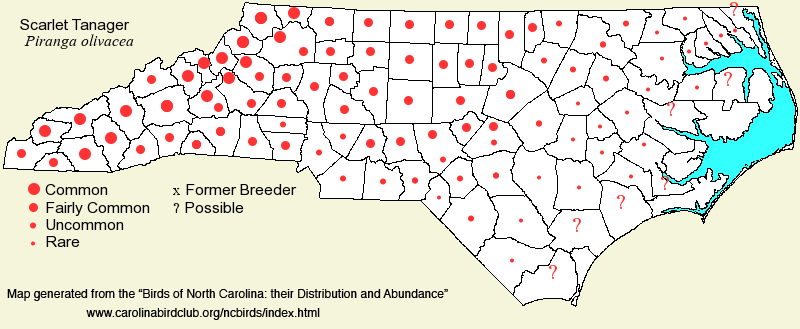 |  |
|
Scarlet Tanager - Piranga olivacea CARDINALIDAE Members: | Search Common: Search Scientific: |
|
|
|||||||
| General Comments | Certainly one of the most beautiful birds in North America, the Scarlet Tanager is a classic bird of the Eastern deciduous forest, though it is scarce as a breeder in the Deep South. Fortunately, this species spread southward and eastward in the 1960's and 1970's as a breeder, to include not only North Carolina's mountains and foothills (where it had long been a breeder) but also the entire Piedmont and much of the northern half of the Coastal Plain. To date, it still does not nest in the southeastern third to half of the Coastal Plain (or is very rare and sporadic), but it does at least pass thru in migration, if uncommonly. Breeding habitat is typically mature hardwood forest, favoring somewhat mesic sites on slopes, though it does breed in bottomlands, in some drier oak forests, and in some areas where mixed with scattered conifers. Unlike with the Summer Tanager, it seldom breeds in wooded residential areas, at golf courses, or other woodlots near human habitation. Not surprisingly, it winters in the tropics, though there are a scattering of winter reports for the state. However, there are apparently no photos of birds in the winter, unlike with Summer and Western tanagers; thus, photographs are strongly encouraged to fully document this species in the winter season. | ||||||
| Breeding Status | Breeder | ||||||
| NC BRC List | Definitive | ||||||
| State Status | |||||||
| U.S. Status | |||||||
| State Rank | S5B | ||||||
| Global Rank | G5 | ||||||
| Coastal Plain | Summer resident, and transient. In summer, currently uncommon to locally fairly common in the northwestern portion of the province, such as in the Roanoke River floodplain and slopes; rare to uncommon from the Great Dismal Swamp area southwestward though the central portion of the province, to the Sandhills; rare eastward to the central part of the region. Essentially absent (apparently) from the Pamlimarle Peninsula (Tidewater area south of Albemarle Sound), Croatan National Forest, and other southern Coastal Plain areas, though there are isolated summer reports from these areas; absent along the coastal strip. In migration, rare to uncommon in fall, and rare in spring; along the coast, usually seen only in the fall. Mainly mid-Apr to mid-Oct. The only winter reports appear to be one at Wilmington on 10 Feb (no year given, in Pearson et al., 1959), and one at Alligator River NWR, 2 Jan 2005 [Chat 69:85 link]. Peak counts: | ||||||
| Piedmont | Summer resident, with migratory movements. Currently, fairly common in summer over most of the region, though uncommon in some of the more heavily urbanized counties. Formerly did not breed over much of the Piedmont (e.g., not a breeder in Wake by the middle to late 1960's) [Chat 33:53-71 link]. Can be fairly common to at times common in fall migration. Mainly mid-Apr to mid-Oct; three winter reports -- one at North Wilkesboro, 30 Jan - 2 Feb 1972; one at Greensboro, 28-29 Dec 1988; and an "adult male" at Raleigh on 26 Feb 1996 -- presumably in basic plumage and not in breeding plumage. Peak counts: | ||||||
| Mountains | Summer resident, with migratory movements. Fairly common to common in summer, up to about 5,000 feet; seldom above that elevation. Can be common in migration, more likely so in fall. Mainly mid- or late Apr to mid-Oct. One photographed in Asheville (Buncombe) on 27-28 Nov 2024 was quite late. One winter report -- a female seen at Maggie Valley (Haywood) on 2 Jan 2015 [Chat 79:106 link]. Peak counts: | ||||||
| Finding Tips |
The species should be heard and seen in a morning of birding in the mountains and most of the Piedmont, from the latter parts of Apr into Jun. *** to **** | ||||||
| Attribution | LeGrand[2025-02-06], LeGrand[2023-04-10], LeGrand[2016-12-18] | ||||||
| NC Map Map depicts all counties with a report (transient or resident) for the species. | Click on county for list of all known species. |
| NC Breeding Season Map Map depicts assumed breeding season abundance for the species. |  |